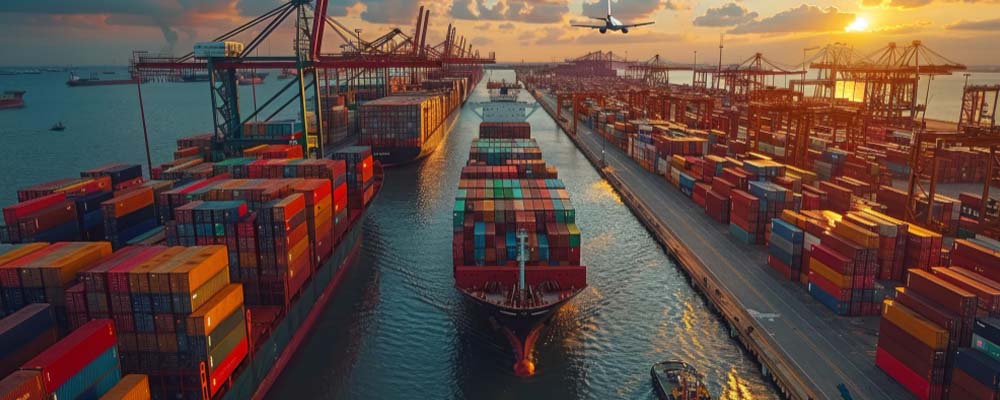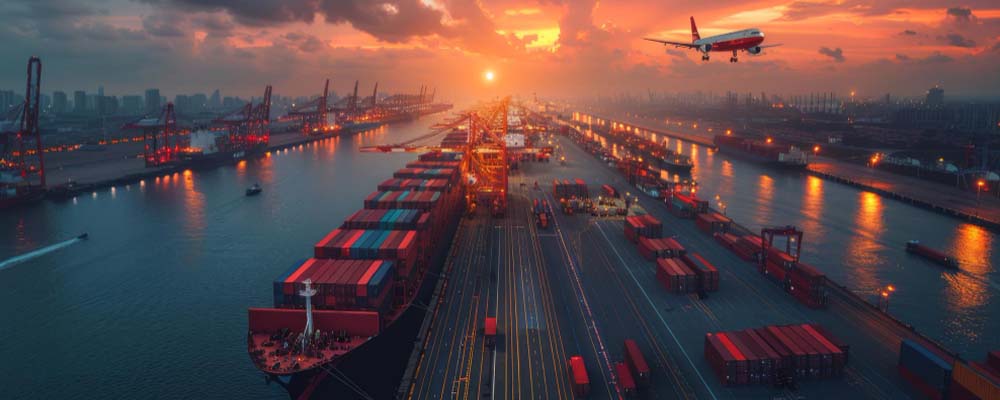
The Port of Los Angeles is a crucial logistics hub for global maritime trade. With its strategic location on the Pacific Coast, it has evolved into a key player in international shipping and transport. This post will explore the essential features of the port, its economic and global impact, and offer insights to help industry stakeholders efficiently navigate this bustling gateway.
5 Key Features of the Port of Los Angeles
World-Class Infrastructure
The Port of Los Angeles boasts state-of-the-art infrastructure designed to handle vast quantities of goods seamlessly. The port spans over 7,500 acres with 43 miles of waterfront. It offers 25 cargo terminals, including container, breakbulk, dry and liquid bulk, auto, and warehouse facilities. This extensive infrastructure ensures the port can accommodate a diverse array of cargo types, making it a versatile choice for various industries.
Additionally, the port’s advanced technology systems facilitate efficient cargo handling and tracking. Automated stacking cranes, real-time tracking systems, and RFID technology streamline operations, reducing turnaround times and enhancing productivity.
Extensive Cargo Handling Capacity
With a handling capacity of over 9.2 million TEUs (Twenty-Foot Equivalent Units) annually, the Port of Los Angeles is the busiest container port in the United States. Its expansive container terminals are equipped with high-capacity gantry cranes, ensuring swift and efficient loading and unloading of vessels. This capacity is pivotal for businesses looking to import and export large volumes of goods.
Furthermore, the port’s specialized terminals for automobiles, bulk liquids, and dry goods enable it to handle a wide range of commodities. This flexibility is essential for freight forwarding companies and logistics providers who manage diverse cargo types.
Integrated Rail and Road Networks
The port’s connectivity doesn’t stop at the waterfront. It is seamlessly integrated with major rail and road networks, facilitating efficient transportation of goods to and from the port. The Alameda Corridor, a 20-mile freight rail expressway, links the port to the national rail system, significantly reducing transit times and congestion.
This connectivity extends to major highways such as Interstate 110 and Interstate 710, providing direct access to key distribution centers and markets across the country. For logistics vendors and customs brokers, this integrated network simplifies the movement of goods, ensuring timely deliveries.
Robust Security Measures
Security is paramount at the Port of Los Angeles. The port employs a comprehensive security framework that includes advanced surveillance systems, access control measures, and a dedicated police force. These measures ensure the safety of cargo and personnel and protect against potential threats.
The port also collaborates with various federal and state agencies to maintain a secure environment. This collaboration includes regular drills and exercises to prepare for potential emergencies. For importers, exporters, and e-commerce businesses, these robust security protocols provide peace of mind, knowing their goods are well-protected.
Environmental Sustainability Initiatives
The Port of Los Angeles is committed to environmental sustainability. Its Clean Air Action Plan (CAAP) aims to reduce air pollution and greenhouse gas emissions from port operations. This plan includes initiatives such as the use of electric and hybrid vehicles, shore power for ships, and the implementation of emission reduction technologies.
Furthermore, the port’s Green Omni Terminal Demonstration Project showcases the use of zero-emission technologies and sustainable practices. For manufacturers and producers focused on sustainability, the port’s green initiatives align with their corporate social responsibility goals.
 Economic and Global Impact
Economic and Global Impact
Economic Powerhouse
The Port of Los Angeles is an economic powerhouse, contributing significantly to the local, regional, and national economies. It generates over $259 billion in trade annually and supports more than 1.6 million jobs nationwide. This economic impact extends beyond the immediate vicinity of the port, stimulating growth in various sectors such as transportation, warehousing, and retail.
Additionally, the port’s operations generate substantial tax revenues, funding essential public services and infrastructure projects. For freight forwarding companies and logistics providers, the port’s economic vitality translates to numerous business opportunities and a stable operating environment.
Gateway to International Markets
The Port of Los Angeles is a vital gateway for international trade, connecting the U.S. with markets in Asia, Europe, and beyond, thanks to its strategic Pacific Rim location.
This global connectivity is essential for importers, exporters, and e-commerce businesses looking to expand their market reach. By leveraging the port’s extensive network of shipping routes and trade partnerships, businesses can efficiently transport goods to and from international destinations, enhancing their competitive edge.
Fostering Innovation and Technology
Innovation and technology are at the core of the Port of Los Angeles’s operations. The port continuously invests in cutting-edge technologies to enhance efficiency, reduce costs, and improve customer service. These investments include blockchain for secure transactions, AI for predictive analytics, and smart sensors for real-time monitoring.
For logistics vendors and industry professionals, the port’s commitment to innovation ensures that they have access to the latest tools and technologies, enabling them to stay ahead of the competition and meet the evolving demands of the market.
Navigating the Port of Los Angeles Efficiently
Pre-Arrival Planning
Efficient navigation of the Port of Los Angeles begins with thorough pre-arrival planning. This planning involves coordinating with port authorities, shipping lines, and logistics partners to ensure that all necessary documentation and permits are in order. This includes customs declarations, shipping manifests, and import/export licenses.
Additionally, businesses should leverage the port’s online tools and resources for real-time updates on vessel schedules, berth availability, and cargo status. These tools enable importers, exporters, and customs brokers to plan their operations effectively and minimize delays.
Streamlined Cargo Handling
Once cargo arrives at the port, streamlined handling processes are crucial for efficient operations. Businesses should work closely with terminal operators to ensure that cargo is loaded and unloaded promptly. This cooperation includes providing accurate cargo details, following terminal procedures, and using the port’s automated tracking and documentation systems.
Furthermore, companies should take advantage of the port’s rail and road connectivity to expedite the movement of goods to and from the port. Coordinating with transportation providers and utilizing intermodal services can significantly reduce transit times and costs.
Leveraging Port Services
The Port of Los Angeles offers a wide range of services to support efficient cargo operations. These services include warehousing, distribution, and value-added logistics such as packaging, labeling, and assembly. By leveraging these services, businesses can streamline their supply chains and enhance the overall efficiency of their operations.
Additionally, the port’s customer service team is available to assist with any inquiries or issues that may arise. For logistics vendors and industry professionals, building strong relationships with port personnel can facilitate smoother operations and ensure timely resolution of any challenges.
Mitigating Risks
Risk mitigation is a critical aspect of navigating the Port of Los Angeles efficiently. Businesses should conduct regular risk assessments to identify potential vulnerabilities in their supply chains and develop contingency plans to address them. This includes diversifying transportation routes, securing insurance coverage, and implementing robust security measures.
In addition, staying informed about industry trends, regulatory changes, and geopolitical developments can help businesses anticipate and respond to potential disruptions. For e-commerce businesses and manufacturers, proactive risk mitigation strategies are essential for maintaining the continuity and resilience of their operations.
 Conclusion
Conclusion
The Port of Los Angeles is essential to the global supply chain, with top-tier infrastructure, vast cargo capacity, and strong links to international markets. By utilizing its services, businesses can efficiently navigate the port and benefit from its economic influence.
For freight forwarders, logistics providers, importers, and exporters, the Port of Los Angeles is a strategic asset driving growth and competitiveness. Staying informed and proactive enables industry professionals to optimize operations, manage risks, and achieve long-term success in global trade.
Explore more about how the Port of Los Angeles can benefit your business and start optimizing your supply chain today.




 Economic and Global Impact
Economic and Global Impact Conclusion
Conclusion



